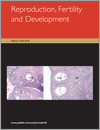Reproduction, Fertility and Development
Volume 31
Number 9 2019
R-Spondin 1 (RSPO1) plays important role in sex differentiation and sex control. In this study we cloned and evaluated the expression of RSPO1 in Pelodiscus sinensis, and found that exogenous oestradiol and an aromatase inhibitor affected external embryo morphology, growth status and the sex ratio. These results will contribute to studies of the potential molecular mechanisms underlying sex differentiation and sex control in P. sinensis.
The aim of this study was to confirm the expression of oxytocin receptor (OTR) and sex hormone-binding globulin (SHBG) in the testis and epididymis of dogs, correlating these data with reproductive features. Positive correlations were found between OTR and SHBG expression in both the testis and epididymis, as well as between OTR and SHBG and several sperm attributes. Together, the results suggest that OTR and SHBG play key roles in male reproductive success.
Abundant MAP3K8 is expressed on porcine CLs, especially in the mid luteal phase. MAP3K8 mediates P4 synthesis by regulating steroidogenic acute regulatory protein (STAR), P450 cholesterol side chine cleavage enzyme (CYP11A1) and 3β-hydroxysteroid dehydrogenase (HSD3B) gene expression in cultured porcine luteal cells. LH has a stimulatory effect on MAP3K8 expression in porcine luteal cells, and MAP3K8 mediates the LH-induced stimulation of P4 synthesis through the PKA/MAPK signalling pathway in porcine CL.
Here we describe a highly unusual cellular structure of the ovary from the hairy – nosed wombat. We show that there are numerous lobules of luteinised interstitial tissue, many of which contain a localised region of non-cellular material with abundant glycoproteins. We suggest that these lobules arise from ovarian atretic follicles, within which a degenerated zona pellucida is sometimes present. The endocrine secretion of this tissue may result in the long oestrous cycle of the wombat.
This work offers a novel insight into the effect of progesterone (P4) on bovine sperm hyperactivation and associated release from the oviductal epithelium. Through investigation of the molecular mechanism of action of P4 we have demonstrated that hyperactivation induced by P4 plays a role in the detachment of bovine sperm from oviductal epithelial cells and that the presence of extracellular Ca2+ is essential in this response to P4. These findings increase our understanding of how sperm are released from reservoirs in the upper female reproductive tract.
Contraception can be used as part of a strategic approach to manage reproductive output in endangered species breeding programs. The efficacy of contraceptive implants was established in captive Tasmanian devils, with females prevented from breeding for one to two years, without negative side effects. These implants are now routinely used to manage behavioural and reproductive health in the Tasmanian Devil insurance population.
Characterisation of fetal fluids can help to unravel the pathophysiology of placentitis. Protein composition of amniotic and allantoic fluids of healthy mares and mares with placentitis were assessed. One-hundred and twelve proteins were present in allantoic and amniotic fluids. Placentitis resulted in 10 proteins being upregulated and 10 downregulated in allantoic fluid. The findings in this paper suggest that fetal-fluid proteomics has the potential to be a useful technique to better understand the pathophysiology of disease.
Alterations in gene expression in early embryos can impact developmental competence. The aim of the work presented here was to determine how a chromatin remodelling protein, BRD7, is trafficked in the cells of cleavage-stage porcine embryos. Our findings provide new insight into chromatin remodelling dynamics and may further our understanding of the factors that lead to aberrant gene expression.
Bovine oocyte cryopreservation remains ineffective due to the low ability of cryopreserved oocytes to undergo proper embryo development. This study examined whether the addition of the exopolysaccharide (EPS) ID1, synthesised by Pseudomonas sp. ID1, to vitrification and warming solutions could improve oocyte tolerance to vitrification. The findings show that 10 µg mL−1 EPS ID1 may help stabilise spindle morphology and improve embryo development in vitrified–warmed adult cow oocytes.
Predicting male fertility is challenging, but assays in which sperm from different males compete have great predictive potential. Establishing a differential fluorescent tagging of mammalian sperm made a competitive oviduct binding assay possible, which detected subtle influences of semen preservation on sperm function. The labelling approach is applicable to a range of species and may reinforce the use of competitive sperm assays.
CRISPR/Cas9 technology combined with zygote injection is an efficient method in the production of gene-edited large animal models for biomedicine and agriculture. However, the delivery system for microinjection in large animals refer to methods established in mice. We examined the targeting efficiency in 362 goat zygotes, and suggested an optimised injection combination for efficient genome editing in large animals.





